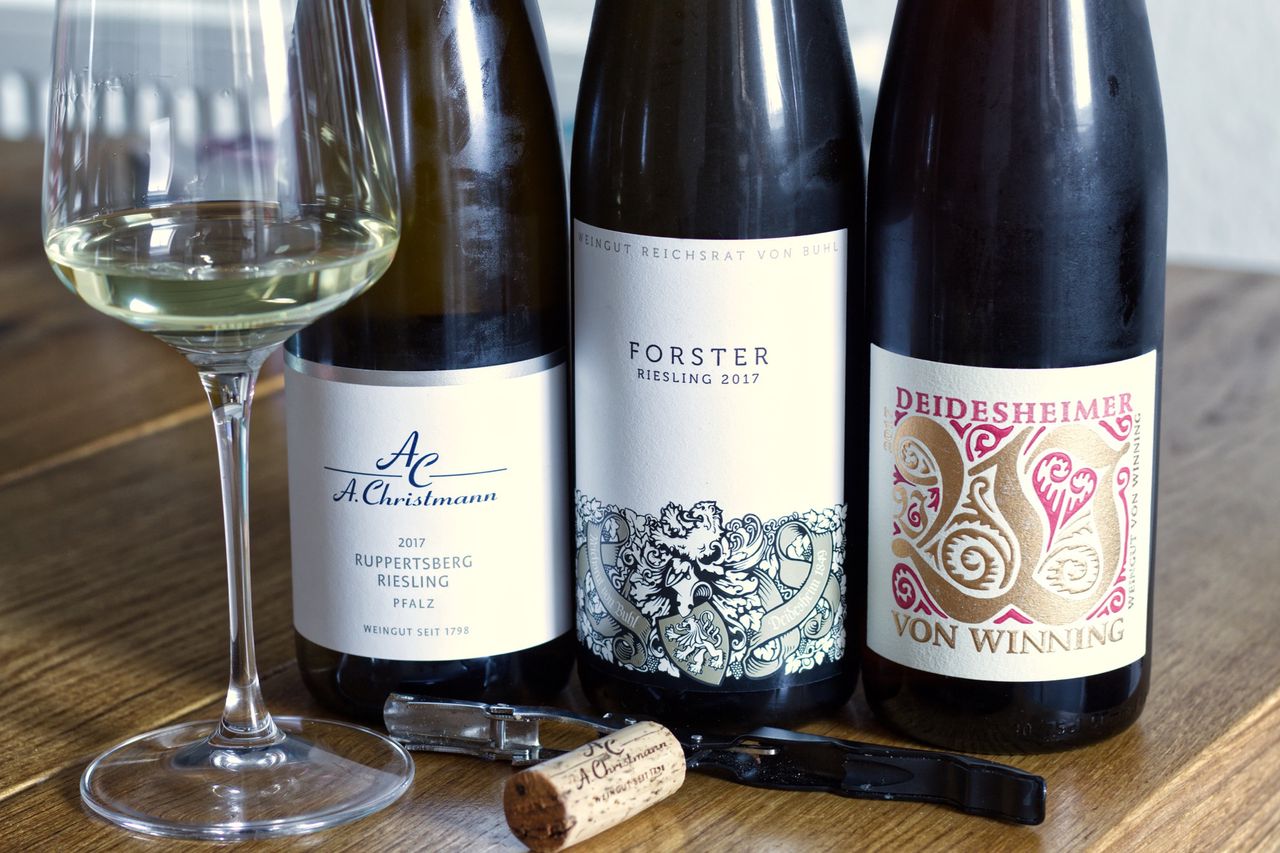Three Bottles Ortswein from Pfalz
We are drinking three Ortswein Rieslings from the Palatinate from 2017: Deidesheim Riesling made by von Winning, Forster Riesling from Reichsrat von Buhl and Ruppertsberger Riesling from Christmann.

Ortswein, village wine, is one level above the Gutswein, estate wine, and a good bit below the Grosses Gewächs and in my opinion a great quality level. One is already above the basic qualities, the grapes come from a much more restricted area and yet the wines are relatively cheap to buy and don’t need to disappear in the cellar for years. A great opportunity to see if you like the winemaker’s style or not. Today three Ortswein Rieslings from the Palatinate from three different wineries and three different places end up in our glass. All wines were tasted over two days to see what happens with time and air. The three wines are vintage 2017, so they have already been in the bottle for some time.
Let’s start with the Deidesheimer from the von Winning winery: The wine smells wet, has yellow fruit, some minerality, wet stone, but the dominant feature is the fruit, light yellow, fresh from the tree. Crisp in the mouth, extract provides structure on the palate, juicy, drinkable, almost a little sweet on the tongue. This is a very pleasant wine to drink, pleasing, not simple but somehow it lacks some tension, the edge that would render it interesting. With more air the wine becomes even more fruity, easy-drinking tonight and, tiny spoiler, this will also remain the most drinkable wine of the evening, but not the most exciting.
On the second evening, the Deidesheimer Riesling became rounder, more citrus fruit than pome fruit, soft, minimal wood. Nice, relaxed Riesling with a tiny bit too much residual sugar perhaps.
The next wine comes from the winery Reichsrat von Buhl: The Forster Riesling is creamier on the nose, but also much more sparse and darker in aroma. Little fruit, perhaps a little pear. In the mouth clearly crisper, much acidity, straight, less juicy, less fruity, but with phenolic notes, a nice salinity remains on the lips. The wine offers more resistance, pulling on the cheeks, on the palate. Uncompromisingly dry Riesling, longer, less easy to drink, but with a lot of tension. With air comes a certain creaminess and a little more fullness, nevertheless the most meagre wine with the pointiest acidity.
Day two brings some citrus fruit, fresh lemon juice, wet stone, the wine has lost none of its tight and crisp acidity. The clearest wine of the three, but also the most demanding this time around.
The third wine is from the Christmann winery, a Ruppertsberger. The aroma here is the darkest of the three bottles. In the nose, the wine is fuller, denser and also softer compared to the other two. In the mouth it is very juicy with a nice spice on the palate. Differently juicy when compared to the Deidesheimer Riesling. A few weeks ago I had a glass of fresh jam of white peaches, more fruit sauce than boiled jam, something like that is mixed with stony minerality in the nose. A harmonious wine, with spice, creaminess and length.
On the second day, the creaminess is even more pronounced, the wine feels almost buttery in the mouth, ripe yellow fruit, appears altogether more mature than the other two wines, perhaps an indication of the cork opposite the two screw caps. Who knows.
You can’t go wrong with any of the wines, the Riesling from Deidesheim was the most uncomplicated, at the other end of the spectrum was the wine from Forst. Straight, meagre with strong acidity and stone. The wine from Ruppertsberg is somewhere in between, elegant, deep, long with great fruit but enough complexity and minerality to require attention but if you provide that also deliver excitement.